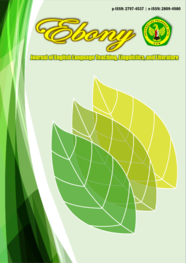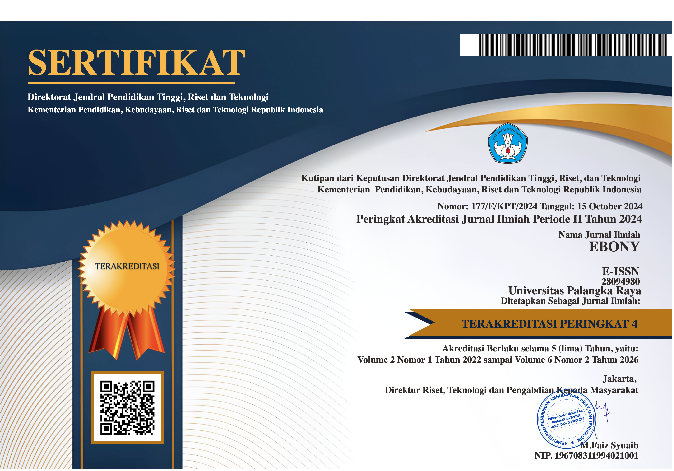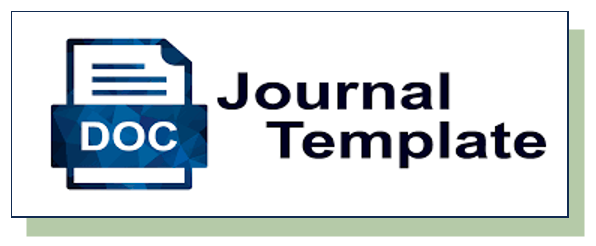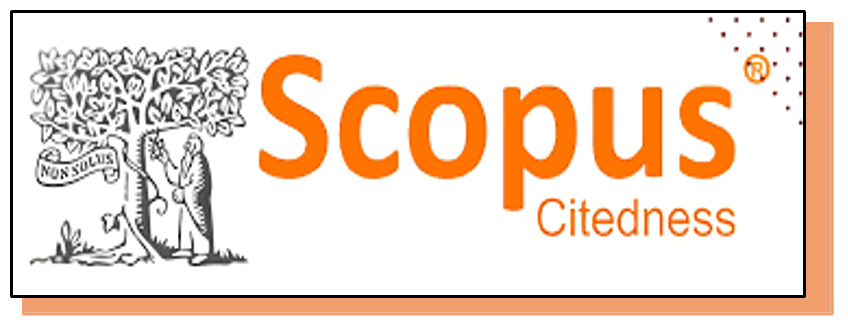Exploring the Techniques Used by the Machine and Human Translation in Translating The Gift of the Magi into Indonesian
DOI:
https://doi.org/10.37304/ebony.v5i2.20360Keywords:
Translation Techniques, Human Translation, Machine Translation, U-DictionaryAbstract
The pros and cons of which one is better in producing good result of translation between Machine Translation (MT) and Human Translation (HT) has been going on for many years. In the attempt to observe which is better between MT and HT, this article focuses on exploring the techniques used by U-Dictionary as a MT and Maggie Tiojakin as a HT in translating The Gift of the Magi into Indonesian. Data in this research are the words, phrases, clauses and sentences related to the translation techniques in the original version of The Gift of the Magi and the two translation versions. The collected data are analyzed qualitatively by using Molina and Albir’s (2002) theory. The results describe that Maggie Tiojakin used 12 techniques; they are adaptation, amplification, compensation, description, discursive creation, established equivalent, generalization, literal translation, modulation, particularization, reduction, and transposition. Meanwhile, U-Dictionary used 8 techniques; they are amplification, borrowing, calque, established equivalent, literal translation, modulation, reduction, and transposition. The dominant translation technique used by Maggie Tiojakin is discursive creation (24.54%), whereas in U-Dictionary, it is literal translation (47.27%). From the different translation techniques used, it can be proven that HT uses more various techniques and has better translation result than MT, in which the translation of the literary works especially a short story done by HT is more accurate, readable, and acceptable.
Downloads
References
Arvianti, G. F. (2018). Human translation versus machine translation of Instagram’s captions: Who is the best? 2nd English Language and Literature International Conference (ELLiC) Proceedings, 2, 531–536. http://103.97.100.145/index.php/ELLIC/article/view/3585/3412
Asi, N., Fauzan, A., Nugraha, R. F., Binti, J. A. Y. P., & Vanesa, N. (2024a). Culturally distinctive features in journalistic text: A case study on students’ vs. AI-generated translations. Yavana Bhasha : Journal of English Language Education, 7(1), 54–67. https://doi.org/10.25078/yb.v7i1.3212
Asi, N., Fauzan, A., Nugraha, R. F., Binti, J. A. Y. P., & Vanesa, N. (2024b). Students’ Strategies and Errors In Journalistic Text Translation. Journal of English Educational Study (JEES), 7(1), 27–36. https://doi.org/10.31932/jees.v7i1.2897
Budianto, S., Andharu, D., & Kartini, R. (2024). Analyzing the differences: U-dictionary and google translate’s English-to-Indonesian speech translation. Research and Development in Education (RaDEn), 4(1), 138–148. https://doi.org/10.22219/raden.v4i1.32316
Farahani, M. V. (2020). Adequacy in Machine vs. Human Translation: A Comparative Study of English and Persian Languages. Applied Linguistics Research Journal. https://doi.org/10.14744/alrj.2020.98700
Freitas, C., & Liu, Y. (2017). Exploring the Differences between Human and Machine Exploring the Differences between Human and Machine Translation Translation Recommended Citation Recommended Citation. https://cedar.wwu.edu/wwu_honors
Halimah. (2018). BAHTERA: Jurnal Pendidikan Bahasa dan Sastra. BAHTERA: Jurnal Pendidikan Bahasa Dan Sastr, 17(1), 11–29. http://journal.unj.ac.id/unj/index.php/bahtera/
Hasibuan, Z. (2020). A Comparative Study Between Human Translation and Machine Translation as an Interdisciplinary Research. Journal of English Teaching and Learning Issues, 3(2), 115. https://doi.org/10.21043/jetli.v3i2.8545
Henry, O. (2022). The Gift of the Magi. Renard Press Limited.
Istiqomah, L., Erawati, M., & Suparno, S. L. (2019). Discursive Creation Technique of English to Indonesian Subtitle in Harry Potter: The Chamber of Secrets Movie. Lingual, 7(1), 1–4. https://ojs.unud.ac.id/index.php/languange/article/view/48085/29585
Khenglawt, V., & Lalṭanpuia. (2018). Perspective and Trends in the Development of Science Education and Research. Proceedings of the Mizoram Science Congress 2018, 141–145. https://doi.org/https://doi.org/10.2991/msc-18.2018.22
Kituku, B., Muchemi, L., & Nganga, W. (2016). A review on machine translation approaches. Indonesian Journal of Electrical Engineering and Computer Science, 1(1), 182–190. https://doi.org/10.11591/telkomnika.v1i1.pp182-190
Lihua, Z. (2022). Retracted: The Relationship between Machine Translation and Human Translation under the Influence of Artificial Intelligence Machine Translation. Hindawi: Mobile Information Systems, 2023, 1–1. https://doi.org/10.1155/2023/9898413
Molina, L., & Albir, A. H. (2002). Translation Techniques Revisited: A Dynamic and Functionalist Approach. Meta Journal Des Traducteurs, 47(4). https://doi.org/http://dx.doi.org/10.7202/008033ar
Muftah, M. (2022). Machine vs human translation: a new reality or a threat to professional Arabic–English translators. PSU Research Review. https://doi.org/10.1108/PRR-02-2022-0024
Nugraha, R. F. (2023). Idiom Translation Quality Assessment on “Landline” Novel by Rainbow Rowell. EBONY: Journal of English Language Teaching, Linguistics, and Literature, 3(2), 119–128. https://doi.org/10.37304/ebony.v3i2.9468
Nugraha, R. F., Asi, N., & Fauzan, A. (2024). WORDS ACROSS BORDER An Introductory Book to Translation. Deepublish. https://deepublishstore.com/produk/buku-words-across-border-an-introductory-book-to-translation/
Putrawan, G. E. (2017). Basic Understanding of Translation; Theoretical and Practical Points of View. Graha Ilmu. https://bintangpusnas.perpusnas.go.id/konten/BK2688/basic-understanding-of-translation-theoretical-and-practical-points-of-view
Venuti, L. (1992). Rethinking Translation: Discourse, Subjectivity, Ideology. Routledge.
Vinay, J. P., & Dalbernet, J. (1958). A methodology for translation. In L. Venuti (Ed.), The Translation Studies Reader. Routledge.
Zong, Z. (2018). Research on the Relations between Machine Translation and Human Translation. Journal of Physics: Conference Series, 1087(6). https://doi.org/10.1088/1742-6596/1087/6/062046
Downloads
Published
How to Cite
Issue
Section
License
Copyright (c) 2025 Erma Sujiyani, Sulamit Syeba, Maida Norahmi , Riniyati Riniyati

This work is licensed under a Creative Commons Attribution 4.0 International License.











